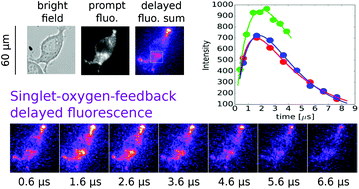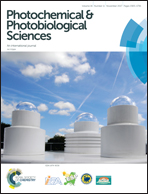Microscopic time-resolved imaging of singlet oxygen by delayed fluorescence in living cells†
Abstract
Singlet oxygen is a highly reactive species which is involved in a number of processes, including photodynamic therapy of cancer. Its very weak near-infrared emission makes imaging of singlet oxygen in biological systems a long-term challenge. We address this challenge by introducing Singlet Oxygen Feedback Delayed Fluorescence (SOFDF) as a novel modality for semi-direct microscopic time-resolved wide-field imaging of singlet oxygen in biological systems. SOFDF has been investigated in individual fibroblast cells incubated with a well-known photosensitizer aluminium phthalocyanine tetrasulfonate. The SOFDF emission from the cells is several orders of magnitude stronger and much more readily detectable than the very weak near-infrared phosphorescence of singlet oxygen. Moreover, the analysis of SOFDF kinetics enables us to estimate the lifetimes of the involved excited states. Real-time SOFDF images with micrometer spatial resolution and submicrosecond temporal-resolution have been recorded. Interestingly, a steep decrease in the SOFDF intensity after the photodynamically induced release of a photosensitizer from lysosomes has been demonstrated. This effect could be potentially employed as a valuable diagnostic tool for monitoring and dosimetry in photodynamic therapy.



 Please wait while we load your content...
Please wait while we load your content...